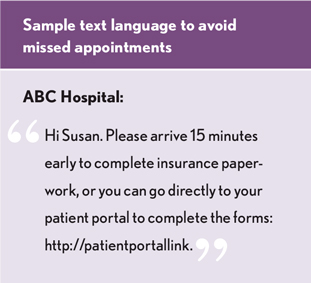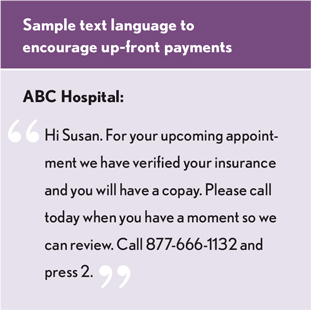How texting taps into better patient communications and savings opportunities
- When adding up the total amount of time spent on the phone and total cost of all documents printed and letters sent over a year, expenses can quickly add up.
- Many adults now prefer to receive and send a text instead of receiving/making a phone call.
- A variety of departments within healthcare organizations can harness the power of a two-way texting platform to achieve cost savings.
Supplies, staff salaries, staffing levels and service agreements are often considered for cost savings. Those costs tend to be associated with some of the high-dollar items in a budget and, therefore, ripe for potential high-dollar savings.
One area frequently overlooked for cost savings opportunities is communications. Why is that the case? Communications may seem like a small area for savings. After all, a phone call to a patient or staff member only takes a few minutes and sending a letter to a patient or staff member isn’t all that expensive.
But when adding up the total amount of time spent on the phone and total cost of all documents printed and letters sent over a year, expenses can quickly add up. Another important consideration: Staff time spent making those calls and assembling those letters is time that could be spent on other tasks.
Furthermore, one must consider the success of these communication methods in achieving their objectives. Consider that a Harris Poll survey found that 29% of consumers do not listen to their voicemails, and that a study on mobile phone usage in the U.S. by Hiya found that 76% of adults choose to not answer a call to their mobile phone from a number they don’t recognize. This will likely include calls made by healthcare organizations.
When letters are sent via the Postal Service, there is no means of determining whether a letter reached its intended location and recipient, and no way of knowing whether the recipient will read, let alone, act on the contents of the letter.
Email is a form of communication more organizations are relying upon, but it has significant shortcomings. One study by Workfront presented in an Oct. 2, 2017, Office Life blog determined that U.S. employees average close to 200 unread or unopened emails in their inboxes at any given time. One can only imagine how many unread emails are in personal inboxes, especially when considering that more than 280 billion emails were sent and received each day in 2018, according to Statista’s “Number of e-mails per day worldwide 2017-23” data. As time has gone on, some of the problems associated with phone calls are extending to emails.
However, text messages offer a platform that typically avoids the shortcomings of other methods and can help healthcare organizations achieve noteworthy, often measurable cost savings.
The case for texting
To understand why texting is an effective communication tool, consider that nearly all U.S. adults (96%) now own cell phones, with smartphone ownership exceeding 80%, notes the Pew Research Center Mobile Fact Sheet, June 12, 2019. This extends to older individuals, with 91% of adults 65 and over owning cell phones and a majority owning smartphones. Many adults now prefer to receive and send a text instead of receiving/making a phone call, according to a Chicago Tribune article, “Americans prefer texting to talking, report says.”
This preference is apparent when considering that 95% of text messages are read within just three minutes of being sent, according to a Forbes article, and 98% of all text messages are read, Mobile Marketing Watch reports. In addition, SalesForce said that the average response time for a text is just 90 seconds. Many people consider not replying quickly to a text as rude, Google researchers stated in a Fortune article. How long is quickly? Within only 20 minutes.
In addition, texting can be completed on a device that’s usually within an owner’s reach. Because there is essentially no limit to what can be included in a standard, short message service (SMS) text message — short messages, longer messages, links to websites, phone numbers, directions — texting offers healthcare providers flexibility.
Healthcare industry texting applications
Let’s examine a few examples of departments within healthcare organizations that can harness the power of a texting platform — more specifically two-way texting that allows interaction with recipients — to achieve cost savings.
Scheduling. Texting can help improve scheduling in several ways. If an organization needs to prompt patients to call and make appointments, such as for annual physicals or routine colonoscopies and mammograms, texting can eliminate outbound calls and mailed letters for many such patients. In addition to reducing manual labor involved with outreach efforts, healthcare-related texts can also encourage patients to make appointments they might otherwise postpone or forget about.
Getting an appointment scheduled is only half the battle. The other half is ensuring that patients keep their appointments. One estimate by SCI Solutions puts the cost of cancelled, skipped or rescheduled healthcare appointments at $150 billion annually. If patients need to cancel an appointment, one cannot assume they will take the time to call to do so. They may choose to simply not show. However, patients may text their need to cancel, if prompted by a message asking them to confirm their appointment. A follow-up text can help with rescheduling the appointment, avoiding lost revenue.
The cost of cancelled, skipped or rescheduled healthcare appointments is $150 billion annually.
Perioperative. If an organization performs surgery, it likely knows how expensive it is to run an OR. An OR Management News article cited OR costs ranging from $22 to $133 a minute.
Texting patients concerning their upcoming surgical appointments can decrease the costs of OR down time by reducing cancellations and no-shows, delays linked to patient non-compliance or late arrivals to the facility. Pre-appointment texts can serve to notify patients about their required arrival times and critical dietary instructions and provide links to any online forms that must be completed.
Nuclear imaging. Texting a patient can eliminate waste associated with nuclear imaging departments, such as the disposal of unused doses when patients miss appointments.

Reducing no shows in a radiology department can also reduce the amount of uncaptured revenue. Radiology loses more uncaptured revenue per patient visit than primary care or other practices due to patients failing to keep appointments, according to research published in Current Problems in Diagnostic Radiology. This research estimated that uncaptured radiology revenue attributable to no-shows likely reaches $1 million annually at a typical U.S. academic medical center.
Patient accounts. Before devoting resources to making calls and/or mailing letters to patients concerning overdue payments, a well-worded, polite text reminding them that payment is due may be all that is required. The text can include a link to an online bill pay portal, if an organization offers such a mechanism.
Don’t be concerned about taking this approach to securing payments. Such a method is familiar to most people, as many other industries already employ texting for payment prompts, including major credit cards and many banks.

Human resources. As previously noted, texting can also help drive down expenses associated with staff costs, and not just labor. Consider how a human resources (HR) department can leverage texting. Automated text campaigns can drive engagement with company-sponsored health and wellness initiatives, including flu shots. When employees are healthy, they are less likely to miss shifts, keeping costs associated with overtime and part-time staff down. The same is true for weather-related matters; HR departments can improve coordination of staff schedules leading up to, during and following a weather emergency.
Texting is also an effective means of boosting staff engagement and loyalty. HR can send texts informing staff about organization milestones and accomplishments, bonuses for employee referrals, scrub sales, volunteer opportunities and other initiatives that can help strengthen satisfaction.
When staff are happy with their employer, they are less likely to seek new employment opportunities. One study cited in ebn estimates that it costs as much as one-third of a worker’s annual salary to replace that individual, while the Society for Human Resource Management found that the average cost-per-hire exceeds $4,400. In short, keeping employees translates into significant savings.
Launching a program
Adding texting as a communication method is straightforward. An organization will initially need to research and select a platform, work with the vendor to set up the system and train staff to use it. Then it’s a matter of building mechanisms to capture patient and/or staff member cell phone numbers, which should include providing a means to opt in and opt out of receiving texts.
Because most organizations already capture phone numbers from patients and staff, this will likely only require adding a place on a form for individuals to add a mobile phone number (if different from the number already provided) and then asking them to click or check a box indicating a willingness to accept periodic texts from the organization.
Once an organization implements patient texting, conducting surveys with participants about their experiences can determine if they found texting useful, if messages were clear and if they had any suggestions for improvements. Organizations are often surprised to discover how many ways texting can deliver both communication and untapped-savings benefits.





